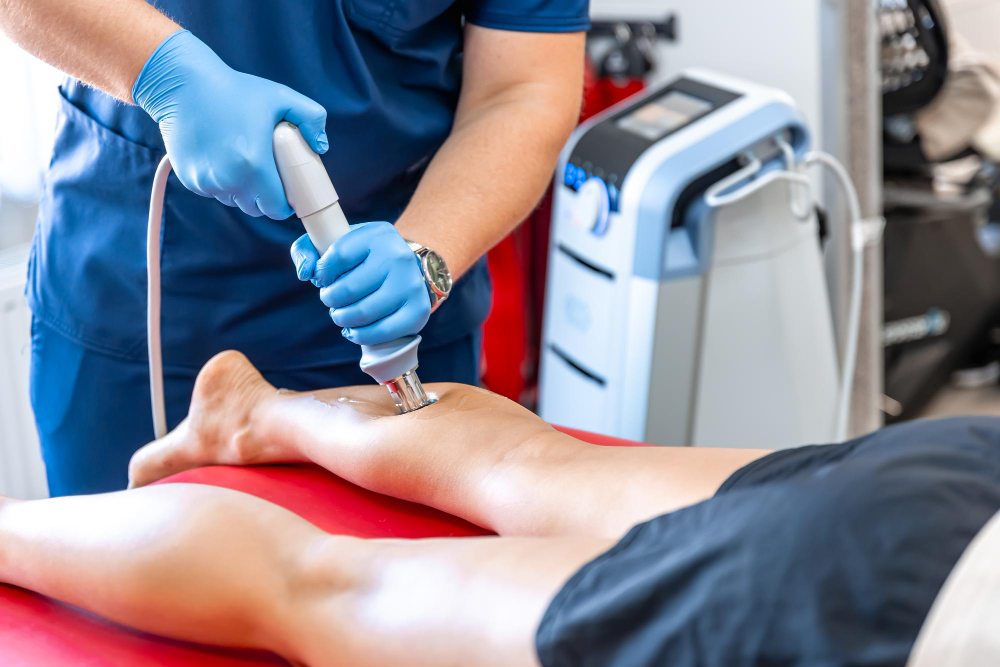Laser treatment for pain management, also known as low-level laser therapy (LLLT) or photobiomodulation, utilizes specific wavelengths of light to stimulate cellular processes that promote healing and reduce pain. Unlike surgical lasers that cut or destroy tissue through intense heat, therapeutic lasers operate at much lower power levels, producing no thermal effects while still delivering significant therapeutic benefits.
The foundation of laser pain therapy lies in photobiomodulation – the process by which light energy is absorbed by cellular components and converted into biochemical energy that enhances cellular function. This mechanism triggers a cascade of beneficial physiological responses that contribute to pain relief, tissue repair, and improved function.
The concept of using light for healing dates back thousands of years, but modern laser therapy began developing in the 1960s following the invention of the laser. Early research demonstrated that low-power laser light could stimulate wound healing and reduce inflammation without causing tissue damage. Over the decades, extensive research has refined our understanding of optimal wavelengths, power densities, and treatment protocols for various pain conditions.
How Laser Therapy Works for Pain Relief
Photobiomodulation Mechanisms
The therapeutic effects of laser treatment occur at the cellular level through several interconnected mechanisms. When laser light penetrates tissue, it is absorbed by chromophores light-sensitive molecules within cells, particularly in the mitochondria. This absorption triggers a series of biochemical reactions that enhance cellular metabolism and function.
The primary target for therapeutic laser light is cytochrome c oxidase, a key enzyme in the mitochondrial respiratory chain. When this enzyme absorbs photons, it increases adenosine triphosphate (ATP) production – the energy currency of cells. Enhanced ATP production provides cells with more energy to carry out repair processes, leading to accelerated healing and reduced inflammation.
Anti-Inflammatory Effects
Laser therapy produces significant anti-inflammatory effects through multiple pathways. The treatment modulates the production of pro-inflammatory cytokines while promoting the release of anti-inflammatory mediators. This balanced inflammatory response helps reduce swelling, redness, and pain associated with various conditions.
Additionally, laser therapy improves microcirculation by promoting vasodilation and enhancing blood flow to treated areas. Improved circulation facilitates the delivery of nutrients and oxygen to tissues while enhancing the removal of metabolic waste products that contribute to pain and inflammation.
Pain Modulation
Laser treatment affects pain perception through several mechanisms. The therapy can block pain signals at the nerve level by affecting sodium-potassium pumps in nerve cell membranes, essentially interrupting pain transmission to the brain. This effect provides immediate pain relief that can last for hours or days following treatment.
The treatment also stimulates the release of endorphins – the body’s natural pain-relieving substances. These endogenous opioids provide sustained pain relief and contribute to improved mood and well-being in patients with chronic pain conditions.
Types of Laser Therapy for Pain Management
Class III Lasers (Low-Level Laser Therapy)
Class III lasers, also known as cold lasers, operate at power levels typically ranging from 5 to 500 milliwatts. These devices produce no thermal effects and are considered the safest category of therapeutic lasers. Class III lasers are commonly used for superficial conditions and can effectively treat pain in muscles, joints, and soft tissues near the surface.
The treatment is completely painless, with patients typically feeling nothing during the procedure. Sessions usually last 5-20 minutes, depending on the condition being treated and the specific device parameters. Class III lasers are often used in clinical settings and are increasingly available for home use under professional guidance.
Class IV Lasers (High-Power Laser Therapy)
Class IV lasers operate at power levels exceeding 500 milliwatts, often reaching 15-25 watts or higher. These high-power devices can deliver therapeutic energy to deeper tissues more effectively than Class III lasers, making them suitable for treating conditions affecting deeper structures such as the spine, large joints, and internal organs.
The increased power allows for shorter treatment times while delivering higher energy doses to target tissues. Class IV laser therapy can produce mild warming sensations, but the treatment remains comfortable and non-invasive. These devices require professional operation due to safety considerations and are typically found in specialized pain management clinics and healthcare facilities.
Conditions Treated with Laser Therapy
Musculoskeletal Pain
Laser therapy has demonstrated significant efficacy in treating various musculoskeletal pain conditions. Arthritis, both osteoarthritis and rheumatoid arthritis, responds well to laser treatment, with patients experiencing reduced joint pain, improved mobility, and decreased inflammation. The therapy can be particularly beneficial for knee, shoulder, hip, and hand arthritis.
Back pain, including both acute and chronic conditions, represents one of the most common applications of laser therapy. The treatment can address muscle strains, ligament sprains, disc-related pain, and facet joint dysfunction. Many patients experience significant pain reduction and improved function following a course of laser treatments.
Tendinitis and tendinopathy conditions, such as tennis elbow, golfer’s elbow, Achilles tendinitis, and rotator cuff injuries, respond favorably to laser therapy. The treatment helps reduce inflammation in affected tendons while promoting tissue repair and regeneration.
Neuropathic Pain
Neuropathic pain conditions, characterized by damage or dysfunction of the nervous system, can be particularly challenging to treat with conventional approaches. Laser therapy offers a unique advantage in these cases by directly affecting nerve function and promoting nerve regeneration.
Diabetic neuropathy, a common complication of diabetes affecting peripheral nerves, has shown positive responses to laser treatment. Patients often experience reduced burning sensations, numbness, and tingling in affected extremities. The therapy may also help slow the progression of nerve damage when used as part of comprehensive diabetes management.
Carpal tunnel syndrome, caused by compression of the median nerve at the wrist, can benefit from laser therapy’s anti-inflammatory and nerve-regenerating effects. Many patients experience reduced pain, numbness, and improved hand function without the need for surgical intervention.
Wound Healing and Tissue Repair
While not exclusively a pain condition, impaired wound healing often involves significant discomfort and complications. Laser therapy accelerates wound healing by promoting cellular proliferation, enhancing collagen synthesis, and improving blood flow to affected areas.
Chronic wounds, such as diabetic ulcers, pressure sores, and venous insufficiency ulcers, have shown remarkable improvement with laser treatment. The therapy not only promotes healing but also provides pain relief associated with these challenging conditions.
Fibromyalgia and Chronic Pain Syndromes
Fibromyalgia, characterized by widespread musculoskeletal pain and tender points, presents unique treatment challenges. Laser therapy offers a gentle, non-invasive approach that can help reduce pain intensity and improve quality of life for fibromyalgia patients.
The treatment’s ability to modulate pain perception and reduce inflammation makes it particularly suitable for complex chronic pain syndromes where multiple mechanisms contribute to symptom development and maintenance.
Benefits and Advantages of Laser Pain Therapy
Non-Invasive Nature
One of the primary advantages of laser therapy is its completely non-invasive nature. Unlike surgical interventions or injection-based treatments, laser therapy requires no incisions, needles, or tissue manipulation. This characteristic makes it suitable for patients who cannot tolerate more invasive procedures or wish to avoid surgical risks.
The non-invasive approach also eliminates the need for anesthesia, reduces infection risks, and allows for immediate return to normal activities following treatment. Patients can typically resume work and daily activities immediately after laser therapy sessions.
Drug-Free Pain Relief
Laser therapy provides pain relief without the use of medications, making it an attractive option for patients concerned about drug side effects, interactions, or dependency issues. The treatment can reduce reliance on pain medications, including opioids, NSAIDs, and other analgesics.
For patients who experience adverse reactions to pain medications or have contraindications to drug therapy, laser treatment offers a safe alternative approach to pain management. The therapy can also complement existing medication regimens, potentially allowing for dose reductions while maintaining effective pain control.
Minimal Side Effects
Therapeutic laser treatment has an excellent safety profile with minimal reported side effects. The most common adverse effects are mild and temporary, including slight redness or warmth at the treatment site that typically resolves within hours.
Unlike many pain management approaches, laser therapy does not cause systemic side effects, drug interactions, or long-term complications. This safety profile makes it suitable for long-term use and repeated treatment courses as needed.
Improved Function and Quality of Life
Beyond pain relief, laser therapy often leads to improved function and enhanced quality of life. Patients frequently report increased mobility, better sleep quality, improved mood, and greater ability to participate in daily activities and exercise.
The functional improvements achieved through laser therapy can have cascading positive effects on overall health and well-being, potentially reducing the need for other healthcare interventions and improving long-term outcomes.
Future Developments in Laser Pain Therapy
Research continues to advance our understanding of optimal laser therapy protocols and expand applications for pain management. Emerging technologies include combination treatments that integrate laser therapy with other modalities, such as electrical stimulation or targeted drug delivery.
Personalized treatment approaches based on individual patient characteristics, genetic factors, and biomarkers may improve treatment outcomes and reduce response variability. Advanced imaging techniques may help optimize laser parameters and monitor treatment progress in real-time.
Portable and home-use laser devices are becoming increasingly sophisticated, potentially expanding access to laser therapy and allowing for more convenient treatment schedules. However, professional guidance remains important to ensure safe and effective treatment.
Conclusion
Laser treatment represents a valuable addition to the pain management toolkit, offering a safe, non-invasive approach that can provide significant relief for various chronic pain conditions. The therapy’s ability to promote healing, reduce inflammation, and modulate pain perception makes it particularly attractive for patients seeking alternatives to medications or invasive procedures.
Patients exploring comprehensive pain management strategies should discuss various non-invasive treatment options with their healthcare providers to develop personalized approaches that address their specific needs and conditions. Visit https://scclittleelm.com/ to know more.

